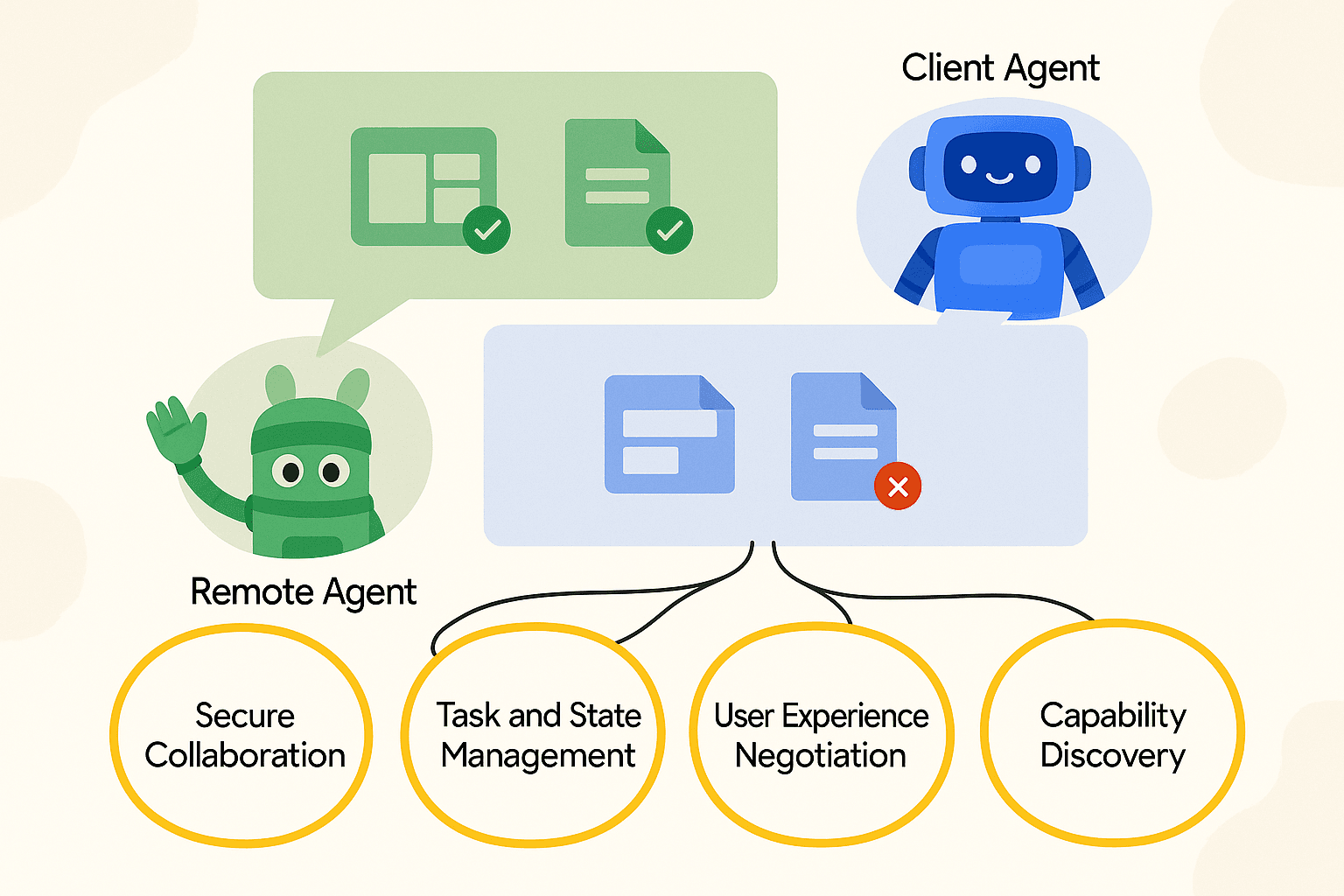Agent2Agent
Protocola2a protocol, google a2a protocol, what is a2a protocol, a2a vs mcp
A new era of agent interoperability. The A2A Protocol (also known as google a2a protocol) enables seamless collaboration between AI agents across different platforms and frameworks. Curious what is a2a protocol or want to compare a2a vs mcp? Discover how A2A and MCP together empower agentic AI.
What is A2A Protocol?
A2A Protocol is an open standard (sometimes referred to as google a2a protocol) that enables AI agents to communicate and collaborate across different platforms and frameworks, regardless of their underlying technologies. If you are wondering what is a2a protocol or want to know about a2a vs mcp, this site will help you understand the differences and synergy between a2a protocol and mcp.
It's designed to maximize the benefits of agentic AI by enabling true multi-agent scenarios, creating a foundation for the next generation of intelligent applications. The a2a mcp combination is especially powerful for developers seeking interoperability.
A2A Protocol Technical Overview
3:45
Universal Interoperability
Enables agents to work together seamlessly across different platforms and frameworks, regardless of their underlying technologies.
Enterprise-Grade Security
Built with enterprise-grade authentication and authorization, supporting OpenAPI's authentication schemes.
Flexible & Scalable
Supports everything from quick tasks to long-running research, with real-time feedback and state updates.
Key Features
A2A Protocol is designed with six key principles to enable seamless agent interoperability across different platforms.
Open Standard
Built on existing standards including HTTP, SSE, and JSON-RPC for easy integration with existing IT stacks
Secure by Default
Enterprise-grade authentication and authorization with support for OpenAPI's authentication schemes
Multi-Modal Support
Supports various modalities including text, audio, and video streaming for comprehensive agent communication
Long-Running Tasks
Designed to support both quick tasks and deep research that may take hours or days to complete
Agent Collaboration
Enables true multi-agent scenarios where agents can collaborate in their natural, unstructured modalities
Real-Time Updates
Provides real-time feedback, notifications, and state updates throughout the task lifecycle
Why Choose A2A Protocol?
A2A Protocol provides a standardized way for AI agents to communicate, eliminating the need for custom integrations between different agent platforms.
- ✓Vendor-neutral, community-driven
- ✓Broad platform compatibility
- ✓Comprehensive documentation
- ✓Future-proof extensibility
Integration Example
// Initialize A2A client
const client = new A2AClient({
agentCard: "https://agent.example.com/.well-known/agent-card",
auth: {
type: "oauth2",
clientId: "client-123"
}
});
// Start an agent task
const task = await client.createTask({
type: "request",
content: {
text: "Analyze this dataset and provide insights"
},
attachments: [
{ type: "file", url: "https://example.com/data.csv" }
]
});How A2A Works?
A2A facilitates communication between a 'client' agent and a 'remote' agent through a structured process. The a2a protocol is often compared with mcp a2a solutions; understanding mcp vs a2a helps clarify their roles in agentic ecosystems.

Capability Discovery
Agents advertise their capabilities using an 'Agent Card' in JSON format, enabling other agents to identify the best agent for a task.
Task Management
Communication is oriented towards task completion, with a defined lifecycle that can be completed immediately or over time.
Collaboration
Agents can send messages to communicate context, replies, artifacts, or user instructions.
User Experience
Messages include 'parts' with specified content types, allowing agents to negotiate the correct format and UI capabilities.
Typical Flow
The A2A Protocol follows a well-defined flow for agent communication and task processing.
Client Server
------- ------
| |
| GET /.well-known/agent-card |
|----------------------------------------->|
| |
| 200 OK (Agent Card) |
|<-----------------------------------------|
| |
| POST /tasks |
| {taskId: "t123", message: "Hello"} |
|----------------------------------------->|
| |
| 200 OK (Task Created) |
|<-----------------------------------------|
| |
| GET /tasks/t123/events |
|----------------------------------------->|
| |
| 200 OK (SSE Stream Established) |
|<-----------------------------------------|
| |
| SSE: {type: "thinking"} |
|<-----------------------------------------|
| |
| SSE: {type: "message", content: "Hi"} |
|<-----------------------------------------|
| |
| SSE: {type: "completed"} |
|<-----------------------------------------|
| |Discovery
Client fetches the Agent Card from the server's well-known URL.
Initiation
Client sends initial message with a unique Task ID.
Completion
Task reaches terminal state (completed/failed/canceled).
A2A MCP
TLDR: Agentic applications need both A2A and MCP. We recommend MCP for tools and A2A for agents. The synergy of a2a mcp is key for next-generation interoperability.

Why Protocols?
- Standard protocols are essential for enabling agentic interoperability
- Tools are primitives with structured inputs and outputs
- Agents are autonomous applications that make decisions
Complementary
- MCP is the emerging standard for connecting LLMs with data, resources, and tools
- A2A is an application-level protocol that enables agents to collaborate
- Together they form a complete solution for agentic applications
Example
- Consider an auto repair shop that fixes cars
- MCP connects agents with their structured tools
- A2A enables ongoing communication and collaboration
Built for Developers: a2a protocol
Join over 50 technology partners including Atlassian, Box, Cohere... Explore how google a2a protocol and a2a vs mcp can help you build robust agentic applications.
Specification
Review the full A2A protocol specification and understand how to implement it in your systems.
Code Samples
Explore available code samples to understand the protocol's structure.
Contribute
Help shape the future of agent interoperability by submitting ideas.